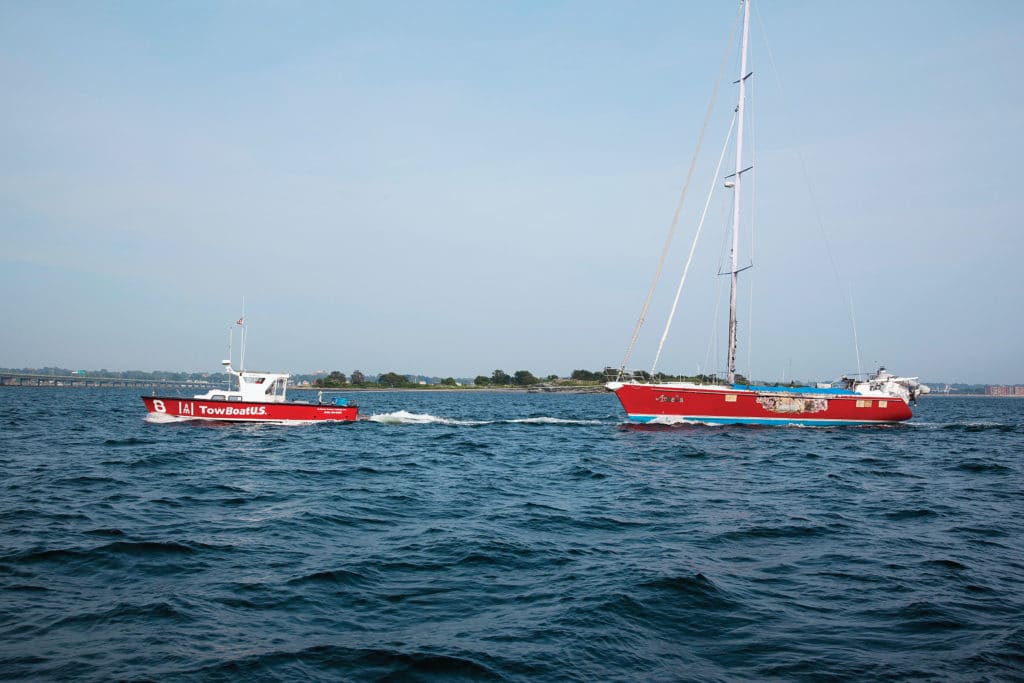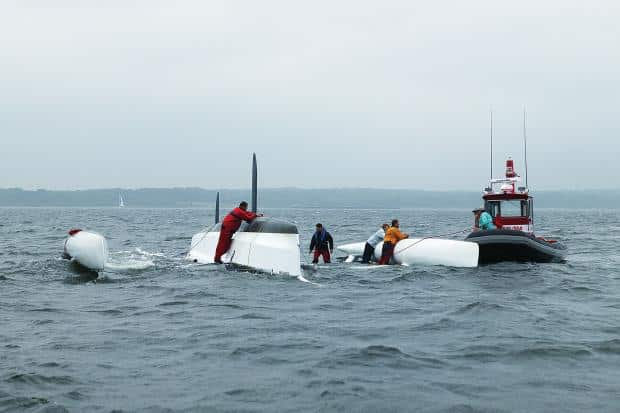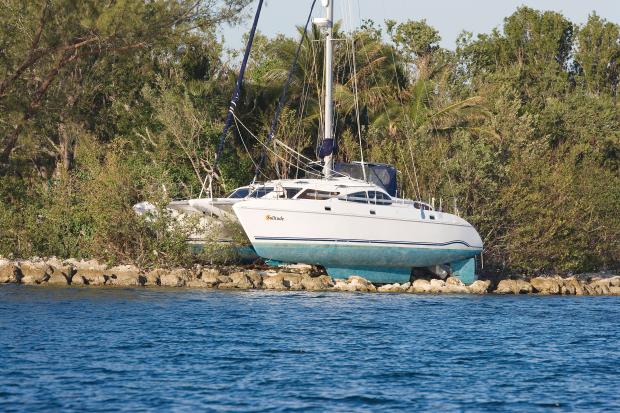
Salvage Rescue
It’s the calm before the storm. Although the weather is quiet in the anchorage, the forecast has the wind increasing to gale force over the next six to eight hours. Mark and Sandi’s boat will be exposed to the building northeast wind and seas, so they haul anchor and head for a protected harbor several miles away. Unfortunately, their chart plotter recently died and the old chart they’re using doesn’t show the sandbar that has been building. They run their 42-foot cutter onto the shoal at over 6 knots. By the time the boat stops, they’re firmly aground with no hope of backing off.
As Mark quickly checks the bilge and determines that there are no leaks, Sandi checks the tide chart. The tide is falling and it’ll be nearly 10 hours before enough water returns to float them off, but well before that the approaching nor’easter’s full force will be pounding them. To make matters worse, the boat is now listing to seaward, which will allow the seas to break directly against and onto her decks and cockpit. Just as Sandi goes below to radio for help, Mark spots a fishing vessel, Heather Anne, coming around the point. Sandi hails it with the VHF and requests assistance.
The skipper of Heather Anne is willing to pull them off. As the tide is dropping rapidly, Mark quickly secures his large storm-anchor rode to his bitts and by using a messenger line gets the other end to Heather Anne. The powerful fishing vessel easily pivots the cutter around and off the sand into deep water. The rudder is jammed, so Mark accepts the offer of a tow to a nearby protected harbor that has a boatyard with haul-out facilities. Now that they’re secured, the U.S. Coast Guard, which has been monitoring the rescue, signs off on the incident.
Dockside at the boatyard, Mark asks the skipper what he owes him. He says not to worry now; he’ll be by in a few days and they can square up. Several days later, while the boat is on jack stands and the rudder is being repaired, the skipper comes by and hands Mark a bill for $15,000 for “services rendered in salvaging the cutter.” Mark and Sandi protest, saying that it only took four hours of time and that they assumed the bill would be based on a reasonable towing fee. The skipper is adamant and tells them that if he had not pulled them off and helped them out that the boat would’ve been destroyed in the storm. If they attempt to launch the boat before payment is made, he adds, he will secure a lien on their vessel.

| |Before accepting help, it is in your best interest to find out if the captain considers the job a tow or a more involved salvage operation. Oral agreements should be witnessed by other crew or even documented with a cell-phone video camera.|
Today’s salvage laws have origins dating back over 2,000 years, when laws in some northern Mediterranean cities allowed awards based on a percentage of the value of a ship and its cargo, the risk involved, and whether the operation was successful. In more recent times, salvage laws have been recognized as an inducement to rescue vessels in distress. Today’s maritime law requires captains to render whatever assistance they safely can when lives are in peril. The law protects them from liability in most cases. These missions of mercy can also coincide with salvage claims.
A clear understanding of the difference between towing and salvage, and how the charges for each are determined, is paramount. A typical towing situation would occur when the skipper of a boat adrift or anchored after an engine problem calls the Coast Guard to request help. Once the Coast Guard ensures that the crew and boat are in no immediate danger, it asks whether there is a specific responder the captain would like to contact. It may be a commercial organization or simply a friend. If there is no one, the Coast Guard issues a marine assistance request broadcast. The Coast Guard will also offer names and contact information of assistance providers in the area and help with communications.
Let’s suppose that a fishing vessel responds to offer a tow. At this point it becomes the responsibility of the disabled boat to negotiate the terms. Step one is to make sure that a clear understanding exists between the parties that a tow is being requested, and what the terms of payment will be. It’s generally understood that if there is no peril, and that there is one tow boat and one towline, it’s a tow and not salvage. It makes no difference whether the towline belongs to the disabled boat or to the tow boat. Payment is usually based on an hourly rate, although it can be for a predetermined total amount. It’s advisable that if the terms are oral, they should at the very least be clear and witnessed, and state that no form of salvage claim will be made. Most cell phones, having the ability to photograph and record audio, make immediate documentation possible.

| |_Complex salvage jobs may involve high-capacity pumps if the hull has been holed, air bags for flotation, and environmental cleanup if fuel has leaked. _|
If assistance becomes a recovery operation, it may be deemed salvage if certain criteria are met (see “Is It Salvage?” on page 54). A recovery operation is either “pure salvage” or “contract salvage.” An ongoing example of a contract salvage operation is the removal of the sunken cruise liner Costa Concordia off the western coast of Italy. Several large salvage firms were awarded detailed contracts by the insurers after winning the bid. Contract salvage payment can be based on “no cure, no pay,” where there is no payment if the recoveryisn’t successful, time and materials, or a combination of both. When the situation allows, insurance companies prefer to enter into a contract because there are fewer financial uncertainties. Pure salvage requires no prior contract. The salvage award is determined either through arbitration or the court.
The amount of a salvage award is based on criteria established during the 1989 International Convention on Salvage (see “Salvage Bounty” on page 55). Amounts can vary from as little as 5 percent to as much as 50 percent or more of a boat’s value, although awards are commonly in the 10 to 20 percent range. The standard forms used by most commercial towing and salvage firms require arbitration in case of dispute.
That’s the case in our scenario. After Mark’s head clears from the shock of the bill, he contacts his insurance company. It sends a marine adjuster the next day to assess the damage and to take Mark and Sandi’s statements about the episode. The insurance covers their boatyard bill, but the bill from Heather Anne will take longer. A meeting is arranged between the adjuster and Heather Anne’s captain, and they negotiate a settlement of $7,500. This avoids going through time-consuming arbitration, or the time and legal fees associated with taking the dispute to court. Fortunately, this is also covered by their insurance.
For a sailor, it’s well worth the time to understand the differences between towing and salvage. You should also be familiar with what is covered by your marine insurance policy and its limitations, and have contact information at the ready for marine-assistance providers in the area you’re sailing. And do keep in mind that towing and salvage operators own and maintain expensive equipment and are usually highly skilled at their jobs. Most are honest and work hard at a sometimes dangerous and challenging profession.








